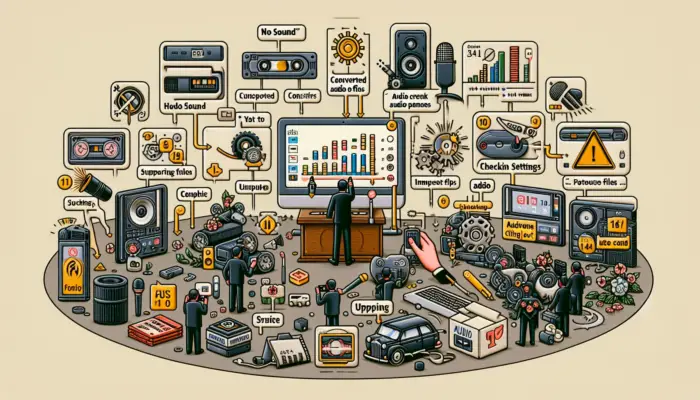Adding audio elements like music, narration, or sound effects can make PowerPoint presentations more engaging and impactful. However, you may encounter playback issues that disrupt the presentation flow. This article covers common audio problems in PowerPoint and troubleshooting tips to resolve them.
Common Audio Playback Issues
Some frequent audio issues include:
- Audio not playing at all
- Audio with no sound
- Audio cutting out or skipping
- Incorrect playback speed/pitch
- Audio-slide sync problems
These issues mainly arise from incompatible formats, misconfigurations, and hardware limitations. Identifying the root cause is key to troubleshooting them effectively.
Troubleshooting Tips
Here are some troubleshooting tips to fix various PowerPoint audio issues:
1. Check Audio File Format Compatibility
Ensure your audio file formats are supported in PowerPoint. Common compatible formats are MP3, WAV, M4A, etc. Consider converting to a recommended format if needed.
2. Optimize Media Compatibility
Go to File > Info > Optimize Compatibility to improve media compatibility issues when sharing presentations. This embeds linked media and upgrades formats.
3. Compress Large Audio Files
Compressing audio files reduces file size without compromising quality. Use tools in software like Audacity to compress before adding to PowerPoint.
4. Update PowerPoint Version
Upgrading to the latest PowerPoint version often resolves playback issues. Newer versions have better multimedia handling capabilities and codec support.
5. Adjust Audio Settings
Check if the correct playback device is selected and audio volume is audible in PowerPoint settings. Incorrect configurations can mute sound.
6. Test on Multiple Devices
Test the presentation on different devices and platforms to ensure consistent audio playback everywhere. Compatibility issues may exist on specific devices.
7. Re-insert Audio File
Try deleting the problematic audio icon from the slide and re-inserting the file. This simple step can help resolve stubborn audio issues at times.
8. Repair Office Installation
Consider repairing your Office installation if audio problems persist. Go to Control Panel > Programs > Microsoft Office > Change > Quick Repair.
9. Update Audio Hardware Drivers
Outdated or corrupt drivers related to speakers, headphones or microphones can cause audio malfunctions. Update drivers to resolve such device-specific issues.
Best Practices
Additionally, follow these audio best practices when working in PowerPoint:
- Use supported audio formats like MP3, AAC for wide compatibility
- Compress large files to optimize performance
- Test audio on multiple systems before finalizing slides
- Embed audio for reliable playback rather than linking files
- Use high-quality external microphones for clear audio recordings
- Place microphone close to mouth when narrating slides to reduce ambient noise
Following these PowerPoint audio troubleshooting tips and best practices will help you host glitch-free, multimedia presentations consistently. Identify the issue root cause, optimize media compatibility, adjust software configurations, update components, and test rigorously.





